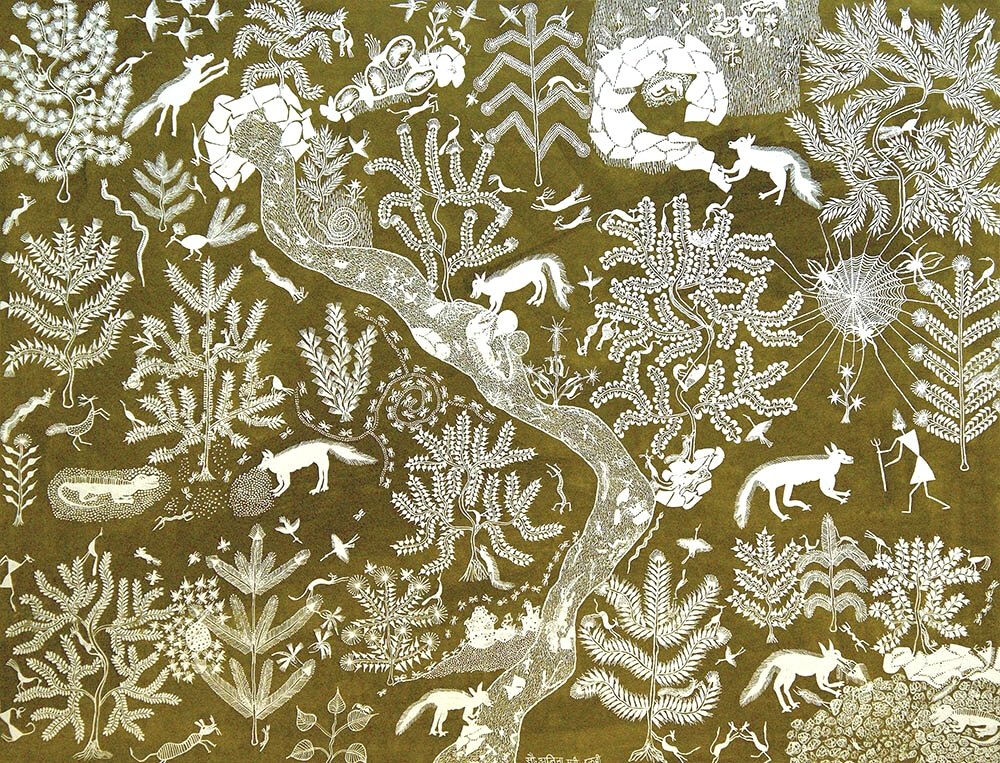Drawing History!
Warli tribal art; traditional themes and practices
Fox and Crocodile, Artist: Anita Balu Mhase, Style: Warli, Medium: Acrylic and cow dung on cloth, Size: 48x36 in
A withdrawn viewing of Warli’s simplistic stick figure painted in white on a red ochre or a brown mud wall might feel too unidimensional if they are not understood in the context of the rich cultural history that these geometric figures carry within themselves. These are much more than what meets the eye; the Warli tribe did not go outside from their immediate to seek inspiration for these murals, they searched inside. This tribe that comes from the mountainous and coastal regions along the Maharashtra-Gujarat border and its surrounding areas used this age-old art form not just as a method of creative expression but as an encapsulation of their way of life. Their art imitated their simple self-sufficient lives.
Primitive Practices
Traditionally, the walls of the houses and other common areas of the community served as a natural canvas for the paintings of the Warli and the paintings served as adornments for their abode. The red ochre, muddy brown or sometimes black hues of walls of the huts were tinted through natural ingredients like brick, iron ores, mud, charcoal, cow dung etc. and to make the figurines, rice power was brought into use, which was then made into a thick paste so that it became a good adhesive. These figurines were either drawn using bamboo sticks or often the tribals used their fingers as well. The white stood out very well against the darker red, brown or black of the background and so these became the signature background and motif colour choices that are being used even today.
The figures painted are a combination of a variety of geometric shapes like circles, triangles and squares. These shapes are not arbitrarily chosen though, each represents a force or element of nature that is revered by the tribe. Triangles are a reminder of the mighty mountains, circle of the central forces of the sky, the sun, the moon and squares are symbolic of the land.
Warli on Hut (Image via Pinterest)
More Than Art
The explanation of this tribal art, however, cannot be reduced down to its technical elements
The Warli Tribesmen and women are traditional storytellers; they follow the oral practice of narrating stories and through those they pass down traditions, knowledge and culture. This oral tradition finds a visual canvas and beautifully painted elaborate tales emerge as a result.
These visual canvases capture the daily rhythms of their life; the forces of nature they worship, their celebratory Tarpa dance, their simplistic belief systems, their laughter, regret, victories, secrets, desires and even tears. An uncountable world of tales exists on the walls and without having to say even a single word they are brought across magnificently, While some depict everyday tales like fishing, hunting, cooking, harvesting etc, some others are more nuanced and teach many a lesson in life.
Image via Shutterstock
Our work at Craft and Community Development Foundation
We at CCDF, for our flagship project ‘The Gondwana Art Project’, collaborate with traditional tribal artists and they are selected through an assessment of the quality of work and their current economic status. These artists are taken in for a residency programme and are provided with a stipend during the period of their residency with the organization. They are guided and given mentorship as well to make their art more suited to contemporary needs. Mr Sundeep Bhandari, our founder sees it as an opportunity for exploration of traditional artistic creativity by bringing it to the forefront.
“Our history is not written, it is drawn: we tell you stories, we tell you about our life.” - Jivya Soma Mashe (world-renowned Warli Artist)
References:
https://www.vam.ac.uk/blog/museum-of-childhood/warli-at-moc
https://garlandmag.com/article/warli/
https://www.seniorcare2share.com/what-is-warli-art/
https://www.artspainter.com/blog/warli-art/
https://www.craftsvilla.com/blog/warli-art-history-maharashtra/
https://medium.com/@anandvilhat75/the-history-and-origin-of-warli-painting-9f6e9ae182f2
https://indianartcraft.wordpress.com/2017/09/12/warli-painting-history-of-warli-art/
https://www.exoticindiaart.com/article/warli-art-the-indigenous-tribal-art/
This article is authored for Craft and Community Development Foundation by Shreya Seth.





